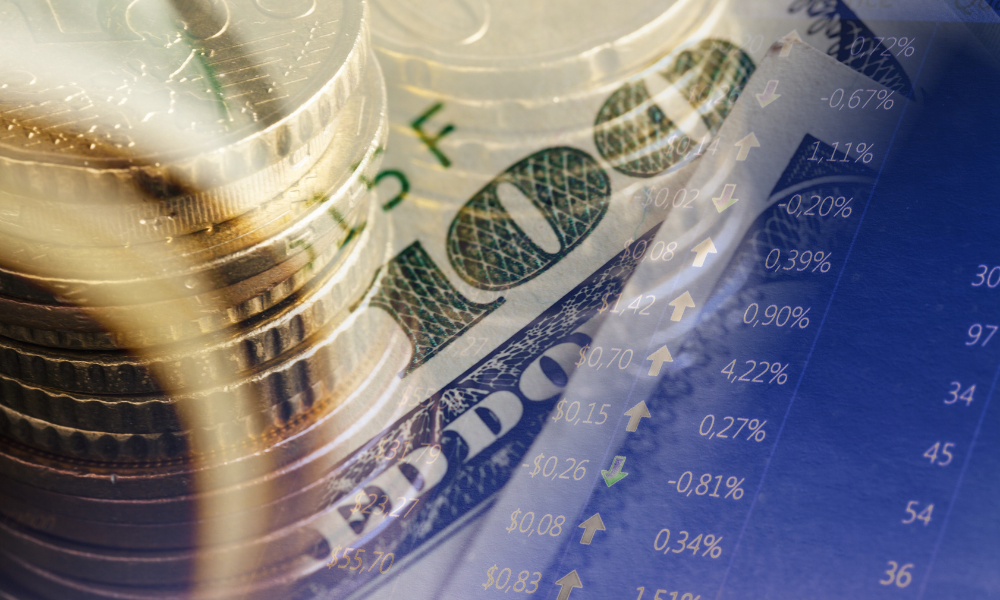

For all the trepidation coursing through the bond market at the start of 2025, Treasuries are up on the month as traders remain on watch for how President Donald Trump’s tariff and immigration policies will develop.
After a rollercoaster stretch, the Bloomberg US Treasury index is up about 0.6% this month through Thursday and benchmark yields are hovering near their lows for this year. A positive January return for the world’s biggest debt market seemed unlikely just weeks ago. Bonds slumped in December and in the first half of this month, partly on speculation that Trump’s proposals for steep tariffs would reignite inflation.
It took until Thursday for the president to indicate he’d follow through on some of his tariff threats, meaning investors who had been bracing for levies to be imposed on day one of his term had a couple weeks of relief. Treasuries also got a major boost mid-month from cooler-than-forecast inflation data, and then as Monday’s equities rout fueled a surge in haven demand.
“The near-term and medium-term macro outlook is exceptionally murky given the lack of clarity around policy,” said Michael de Pass, global head of rates trading at Citadel Securities. “We are in a time of great uncertainty and likely high volatility, so markets are going to cover big and broad ranges.”
Trump on Thursday said he would impose 25% tariffs on imports from Mexico and Canada on Feb. 1, and he said the tariff levels “may or may not rise with time.” He also indicated that he would impose 10% tariffs against China.
Treasuries showed a muted reaction to the Thursday remarks, in part as investors said they were waiting to see if the warnings were a negotiating tactic.
“The bond market is shrugging it off until implementation,” to see what it includes and more importantly how long it lasts, said George Catrambone, the head of fixed income for the Americas at DWS Group.
The fixed-income market faces some other big challenges in the weeks ahead. Data on jobs and inflation are looming that will help shape expectations for the Federal Reserve after policymakers paused their easing cycle this week and signaled they’re in no hurry to cut again.
On Friday an update on the Fed’s favored inflation gauge, the personal consumption expenditures index, showed a 2.6% increase in December from a year earlier, up from a 2.4% pace the previous month — still firmly above the central bank’s 2% inflation target. Ten-year Treasury yields were little changed after the release at around 4.52%, down from a more than one-year high of 4.81% touched on Jan. 14.
Investors are also waiting for announcements on immigration, taxes and fiscal matters. Higher yields and potentially even a rate increase remain on the table if data strengthens on the back of pro-business polices from Trump. There’s also the worry that tariffs and an immigration crackdown may ultimately push up consumer prices and keep Fed rates elevated.
For now, traders still see the Fed’s next move as a cut, although likely not until mid-year. Morgan Stanley economists say they expect the central bank to lower rates in March, while acknowledging that there’s a higher bar for such a move after the Fed’s meeting this week.
Speaking Friday, Fed Governor Michelle Bowman said she wants to see additional progress on inflation before the central bank lowers rates further, and questioned how restrictive policy might be given the economy’s strength.
For Roger Hallam, global head of rates at Vanguard, a 10-year yield between 4.25% and 4.75% “is a fair-value range as long as you can remain in what we’ll call a sort of soft landing-ish type environment.”
Still, he doesn’t rule out yields breaking higher “if you’re seeing more sustained upward pressure on inflation, either as a result of tariffs or immigration or if you see increased fiscal uncertainty driving term premium higher.”
At least some traders are hedging for that scenario. Flows in Treasury options on Thursday included demand for a position targeting an increase in the 10-year yield to around 4.85% by Feb. 21. The cash yield hasn’t been that high since late 2023.
Of course, the 4.8% level is roughly where investors stepped in to buy in mid-January, kicking off the month-end rally.
That was also around when bond giant Pimco advocated owning five- to 10-year Treasuries. They said that yields were “attractive” at a time when valuations in equities and credit markets were stretched.
The asset manager also pointed to the uncertainty that the president will likely inject into markets this year and diminished expectations for central bank easing. Against that backdrop of unpredictability, bonds will offer stability, economist Tiffany Wilding and Andrew Balls, chief investment officer for global fixed income, wrote in a note.

Looking to refine your strategy for investing in stocks in the US market? Discover expert insights, key trends, and risk management techniques to maximize your returns

Driven by robust transaction activity amid market turbulence and increased focus on billion-dollar plus targets, Echelon Partners expects another all-time high in 2025.

The looming threat of federal funding cuts to state and local governments has lawmakers weighing a levy that was phased out in 1981.

The fintech firms' new tools and integrations address pain points in overseeing investment lineups, account monitoring, and more.

Canadian stocks are on a roll in 2025 as the country prepares to name a new Prime Minister.
RIAs face rising regulatory pressure in 2025. Forward-looking firms are responding with embedded technology, not more paperwork.
As inheritances are set to reshape client portfolios and next-gen heirs demand digital-first experiences, firms are retooling their wealth tech stacks and succession models in real time.
